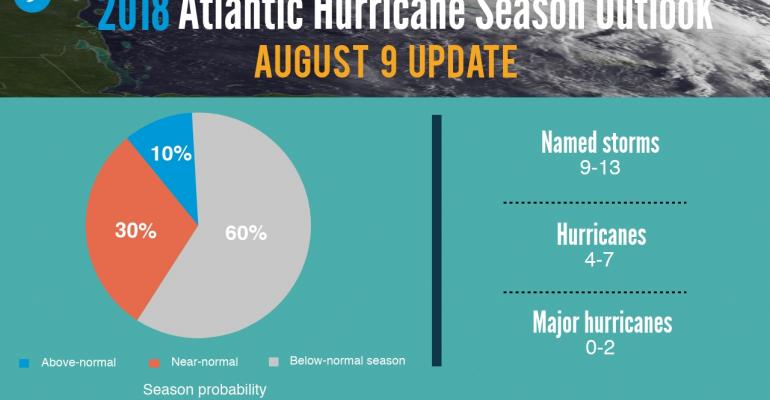Conditions in the ocean and the atmosphere are conspiring to produce a less active Atlantic hurricane season than initially predicted in May, the National Oceanographic and Atmospheric Administration said.
'There are still more storms to come—the hurricane season is far from being over. We urge continued preparedness and vigilance,' said Gerry Bell, lead seasonal hurricane forecaster at NOAA’s Climate Prediction Center.
Likelihood of below-normal season rises to 60%
Seasonal forecasters with NOAA’s Climate Prediction Center have increased the likelihood of a below-normal Atlantic hurricane season to 60% (up from 25% in May) in the updated outlook. The likelihood of a near-normal season is now at 30%, and the chance of an above-normal season has dropped from 35% to 10%.
Zero to two major hurricanes
For the entire season, which ends Nov. 30, NOAA predicts a total of nine to 13 named storms (winds of 39 mph or greater), of which four to seven will become hurricanes (winds of 74 mph or greater), including zero to two major hurricanes (winds of 111 mph or greater).
So far, the season has seen four named storms, including two hurricanes. An average six-month hurricane season produces 12 named storms, of which six become hurricanes, including three major hurricanes.
El Niño and cooler sea surface temperatures
To produce the seasonal update, forecasters take several factors into account. El Niño is now much more likely to develop with enough strength to suppress storm development during the latter part of the season. NOAA’s Climate Prediction Center updated its forecast to a nearly 70% likelihood of El Niño during the hurricane season.
Additionally, sea surface temperatures across the tropical Atlantic Ocean and Caribbean Sea have remained much cooler than average. A combination of stronger wind shear, drier air and increased stability of the atmosphere in the region where storms typically develop will further suppress hurricanes. Storm activity to date and the most recent model predictions also contribute to this update.
Copyright © 2024. All rights reserved. Seatrade, a trading name of Informa Markets (UK) Limited. Add Seatrade Cruise News to your Google News feed.


